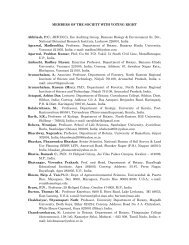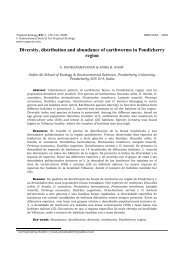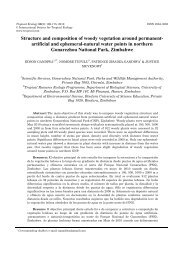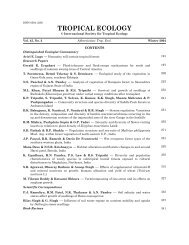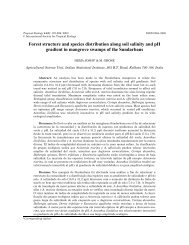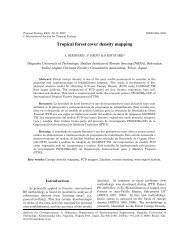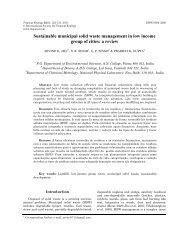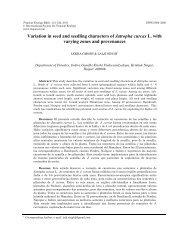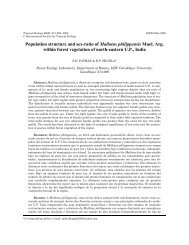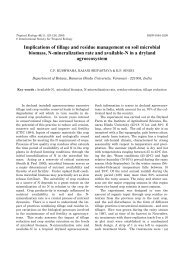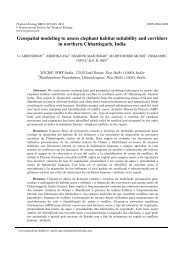80 SOIL SEED BANK AT WAGOMUWA NATIONAL PARKespécies de capim, sementes de algumas espécies florestais pioneiras e espécies <strong>in</strong>festantesagrícolas. Estes bancos sem<strong>in</strong>ais no solo são muito heterogéneos mostrando frequentesagrupamentos de sementes. Esta heterogeneidade afecta fortemente a composição da vegetaçãolocal, a estação de frutificação e os padrões de dispersão de sementes. As sementes de espéciesflorestais lenhosas dificilmente se encontravam na pastagem implicando que a <strong>in</strong>vasão dasflorestas nas pastagens não ocorre espontaneamente. Já as sementes das espécies da pastagemeram frequentemente dispersadas na <strong>in</strong>terior da floresta pr<strong>in</strong>cipalmente pelos herbívoros. Se afloresta, ou as suas margens, forem disturbadas, estas sementes germ<strong>in</strong>arão e estabelecer-seão,e de que resultará uma redução do coberto arbóreo e, subsequentemente, a expansão dapastagem.Key words: Proximity to <strong>seed</strong> source, <strong>seed</strong> dispersal, spatial heterogenity, <strong>tropical</strong> <strong>semi</strong>deciduousforest.Introduction<strong>Spatial</strong> <strong>heterogeneity</strong> <strong>of</strong> species and <strong>seed</strong>densities <strong>of</strong> <strong>soil</strong> <strong>seed</strong> <strong>bank</strong>s is well known for someecosystems like <strong>tropical</strong> humid forests (Whitmore1983) and temperate grasslands (Rice 1989; Rusch1992; Young et al. 1981). Grasslands <strong>of</strong>ten conta<strong>in</strong>large number <strong>of</strong> <strong>seed</strong>s and <strong>the</strong>ir <strong>seed</strong> <strong>bank</strong>s arepersistent. For example, Young et al. (1981)reported 27,400 <strong>seed</strong>s m -2 from Stipa grassland <strong>in</strong>California. Tropical ra<strong>in</strong> forests conta<strong>in</strong> largenumber <strong>of</strong> <strong>seed</strong>s <strong>in</strong> <strong>the</strong> <strong>soil</strong> <strong>of</strong> many pioneer species(Whitmore 1983). In contrast, <strong>the</strong> density <strong>of</strong> <strong>seed</strong>s<strong>in</strong> <strong>tropical</strong> dry forests is found to be low. For<strong>in</strong>stance, Lieberman (1979) found a maximum <strong>of</strong>160 <strong>seed</strong>s m -2 <strong>in</strong> a dry forest <strong>in</strong> Ghana while Hall& Swa<strong>in</strong>e (1980) reported 100 - 700 <strong>seed</strong>s m -2 <strong>in</strong> adry forest <strong>in</strong> <strong>the</strong> same country. In a <strong>tropical</strong> <strong>semi</strong>deciduousforest at Sigiriya Sanctuary, Sri Lanka,<strong>soil</strong> <strong>seed</strong> density <strong>of</strong> 166 ± 127 <strong>seed</strong>s m -2 wasreported (Perera 2005 <strong>in</strong> press).Soil <strong>seed</strong> <strong>bank</strong>s <strong>in</strong> <strong>tropical</strong> humid forests arefound to be highly heterogenous (Garwood 1989;Uhl et al. 1981). Some factors which results <strong>in</strong> highspatial <strong>heterogeneity</strong> <strong>of</strong> <strong>soil</strong> <strong>seed</strong> <strong>bank</strong>s are <strong>the</strong><strong>seed</strong> dispersal patterns <strong>of</strong> <strong>the</strong> different species(Hall & Swa<strong>in</strong>e 1980; Nepstad et al. 1996; Swa<strong>in</strong>e& Hall 1983; Uhl et al. 1981), edaphic factors (e.g.dra<strong>in</strong>age) (Garwood 1989), fire and <strong>seed</strong> predation(Perera, unpublished data). Such constra<strong>in</strong>s affect<strong>seed</strong> germ<strong>in</strong>ation while <strong>the</strong> time <strong>of</strong> disturbancerelative to flower<strong>in</strong>g may limit <strong>the</strong> number <strong>of</strong> <strong>seed</strong>sand species that <strong>in</strong>vade a site (Epp 1987).Accord<strong>in</strong>g to Geritz et al. (1984) and Hartshorn(1980), proximity to a <strong>seed</strong> source is important <strong>in</strong>determ<strong>in</strong><strong>in</strong>g <strong>the</strong> successful colonization andregeneration <strong>of</strong> species <strong>in</strong> a disturbed site. Thisseems to be more relevant to <strong>the</strong> colonization <strong>of</strong>small canopy gaps <strong>in</strong> forests.Tropical <strong>semi</strong>-deciduous forests <strong>in</strong> Sri Lankaare highly disturbed and large canopy gaps occuras a result <strong>of</strong> shift<strong>in</strong>g cultivation (Perera 2001).Regeneration <strong>of</strong> tree species do not occurfrequently <strong>in</strong> <strong>the</strong>se large gaps (Holmes 1954;Perera 2001; Rosayro 1961) and, <strong>the</strong>refore, it isnecessary to assist natural regeneration (Perera etal. 1995; Perera 2001).Soil <strong>seed</strong> <strong>bank</strong>s play a major role <strong>in</strong> naturalregeneration after disturbances such as fire,logg<strong>in</strong>g and overgraz<strong>in</strong>g <strong>in</strong> humid environments(Grime 1981; Roberts 1981; Swa<strong>in</strong>e & Hall 1983),and determ<strong>in</strong><strong>in</strong>g <strong>the</strong> composition and density <strong>of</strong><strong>seed</strong> <strong>bank</strong>s is considered as an essential step <strong>in</strong>artificial restoration <strong>of</strong> degraded vegetation (vander Valk 1989). Therefore, it is necessary toexam<strong>in</strong>e whe<strong>the</strong>r <strong>the</strong> disturbed <strong>tropical</strong> <strong>semi</strong>deciduousforests <strong>of</strong> Sri Lanka could berehabilitated by us<strong>in</strong>g <strong>the</strong>ir <strong>soil</strong> <strong>seed</strong> <strong>bank</strong>s.The objectives <strong>of</strong> this study were to exam<strong>in</strong>e<strong>the</strong> spatial distribution <strong>of</strong> <strong>seed</strong>s <strong>in</strong> <strong>the</strong> <strong>soil</strong> <strong>seed</strong><strong>bank</strong> <strong>of</strong> a <strong>tropical</strong> <strong>semi</strong>-deciduous forest <strong>of</strong> SriLanka and factors responsible for <strong>the</strong> spatial<strong>heterogeneity</strong>. It also assesses <strong>the</strong> potential role <strong>of</strong><strong>the</strong> <strong>soil</strong> <strong>seed</strong> <strong>bank</strong> <strong>in</strong> forest regeneration andevaluates how far <strong>the</strong> proximity to forests affects<strong>in</strong> <strong>the</strong> regeneration <strong>of</strong> forests <strong>in</strong> grasslands, whichare situated adjacent to forests.
PERERA 81Materials and methodsStudy siteThe research was conducted at <strong>the</strong>Wasgomuwa National Park <strong>in</strong> <strong>the</strong> dry zone <strong>of</strong> SriLanka (7 o 34' - 7 o 57' North and 80 o 51' - 81 o 05'East) (Fig. 1), which extended over 37,063 ha area(Green 1990). The forest and adjacent grassland <strong>in</strong><strong>the</strong> sou<strong>the</strong>rn half <strong>of</strong> <strong>the</strong> park were selected for <strong>the</strong>study. The <strong>soil</strong>s <strong>in</strong> <strong>the</strong> area are reddish brown withsome alluvial deposits, and <strong>the</strong> pH varies between6 - 8 (Jayas<strong>in</strong>gham 1991). Generally, <strong>the</strong> meanannual ra<strong>in</strong>fall <strong>in</strong> <strong>the</strong> dry zone <strong>of</strong> Sri Lanka isabout 1000-1900 mm year -1 (Rosayro 1950). Thera<strong>in</strong> is ma<strong>in</strong>ly brought by <strong>the</strong> north-east monsoonbetween October and February. The south-westmonsoon br<strong>in</strong>gs less ra<strong>in</strong> between March and May.Dry periods occur <strong>in</strong> between monsoonal periodsthough <strong>in</strong>termonsoonal ra<strong>in</strong>s also occur. Manmade fires periodically burn <strong>the</strong> grass vegetation.The vegetation <strong>of</strong> <strong>the</strong> area is ma<strong>in</strong>lycharacteristic <strong>of</strong> a <strong>tropical</strong> <strong>semi</strong>-deciduous forests<strong>of</strong> Sri Lanka (Jayas<strong>in</strong>gham 1991). Characteristicspecies <strong>in</strong>clude Berrya cordifolia (Willd.) Burret,Chloroxylon swietenia DC, Drypetes sepiaria(Wight and Am.) Pax. and H<strong>of</strong>fm. and Diospyrosspp. Over <strong>the</strong> forested area, 155 species belong<strong>in</strong>gto 47 families have been identified <strong>in</strong>clud<strong>in</strong>g 107trees, 34 shrubs, 13 lianas and 2 climbers(Jayas<strong>in</strong>gham 1991). The Euphorbiaceae,Legum<strong>in</strong>osae and Rutaceae are <strong>the</strong> dom<strong>in</strong>antfamilies (Jayas<strong>in</strong>gham 1991). Some parts wereheavily disturbed by a cyclone <strong>in</strong> 1978 and <strong>the</strong>seareas have more light demand<strong>in</strong>g forest pioneerspecies.Jayas<strong>in</strong>gham (1991) identified twograssland types <strong>in</strong> <strong>the</strong> area and named <strong>the</strong>m asImperata grasslands and Ischemum/Eragrostisgrasslands. The former occurs widely over <strong>the</strong>area and is dom<strong>in</strong>ated by Imperata cyl<strong>in</strong>dricawhile <strong>the</strong> latter occurs towards <strong>the</strong> easternboundary and is dom<strong>in</strong>ated by Eragrostis sp.and Ischemum sp.Soil sampl<strong>in</strong>gSampl<strong>in</strong>g was done at <strong>the</strong> early period <strong>of</strong> <strong>the</strong>ma<strong>in</strong> ra<strong>in</strong>y season (November 1995). Fourtransects were established at right angles to <strong>the</strong>forest-grassland boundary <strong>in</strong> randomly selectedlocations across slight altitud<strong>in</strong>al gradientdistances <strong>of</strong> 0, 5, 25, 125, 625 and 3125 metrewere marked along <strong>the</strong>se transects from <strong>the</strong>forest-grassland boundary <strong>in</strong>to <strong>the</strong> forest and<strong>the</strong> grassland. In most <strong>of</strong> <strong>the</strong> places, <strong>the</strong> length<strong>of</strong> <strong>the</strong> grassland was less than 3 km from <strong>the</strong>boundary. In such transects, <strong>the</strong> <strong>soil</strong> sampleswere collected from <strong>the</strong> fur<strong>the</strong>st available po<strong>in</strong>t(fp) <strong>in</strong> <strong>the</strong> grassland, which varied between 2000to 3125 m.At each distance along <strong>the</strong> transect, 20 ml<strong>in</strong>es perpendicular to <strong>the</strong> transect were marked.Ten <strong>soil</strong> samples (surface area = 15 x 15 cm;depth = 4 cm) were collected at 2 m <strong>in</strong>tervalsalong <strong>the</strong>se l<strong>in</strong>es. Soil samples were brought to<strong>the</strong> shade house thatched with transparentplastic corrugated sheets, and <strong>the</strong> 10 <strong>soil</strong>samples collected at each distance were mixedtoge<strong>the</strong>r and spread over sterilized sand beds(surface area <strong>of</strong> <strong>the</strong> sand bed was one squaremeter and depth <strong>of</strong> <strong>the</strong> sand layer was fivecentimeters). The beds were well watered us<strong>in</strong>ga hand held f<strong>in</strong>e sprayer and germ<strong>in</strong>ants wereobserved and recorded for 110 days. Seventydays after <strong>the</strong> orig<strong>in</strong>al spread<strong>in</strong>g <strong>the</strong> <strong>soil</strong> surfacewas lightly scarified <strong>in</strong> order to expose buried<strong>seed</strong>s if any. Six sand beds were left withoutany <strong>soil</strong> to detect any contam<strong>in</strong>ation <strong>in</strong> <strong>the</strong>shade house. Dicot <strong>seed</strong>l<strong>in</strong>gs which could not beidentified when very young were potted andidentified after 7-8 months.Fig. 1. Location <strong>of</strong> <strong>the</strong> study site and transects.





